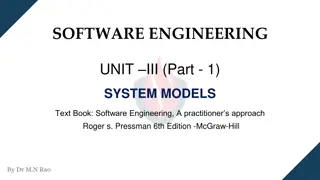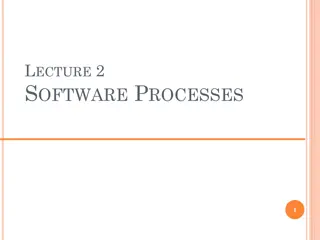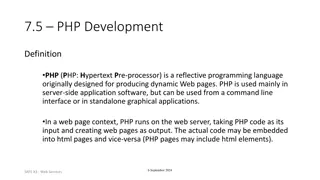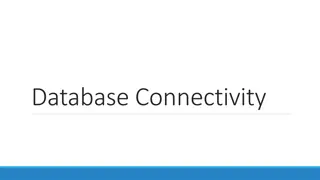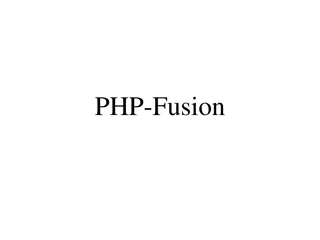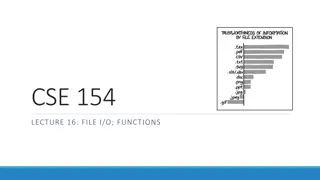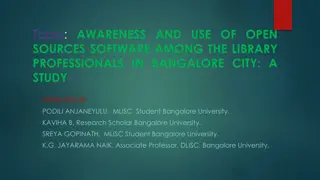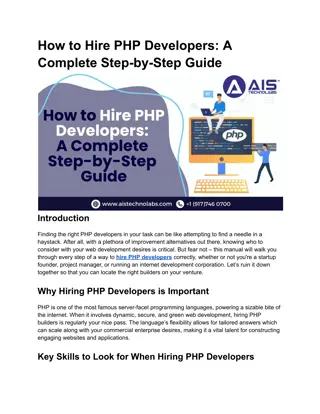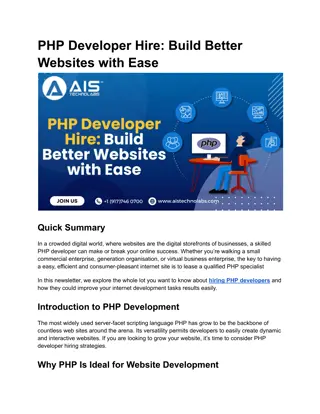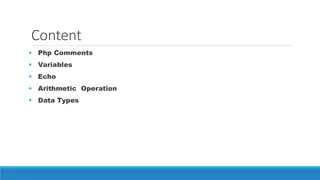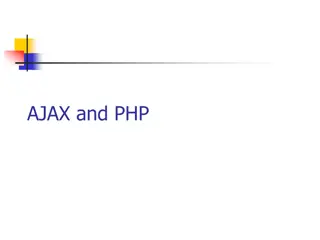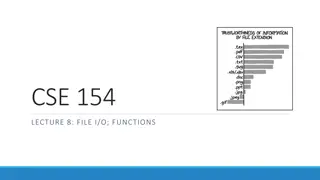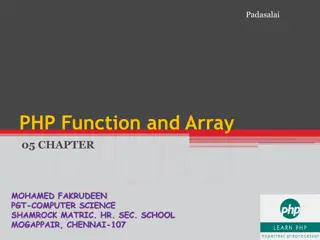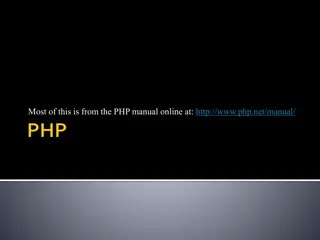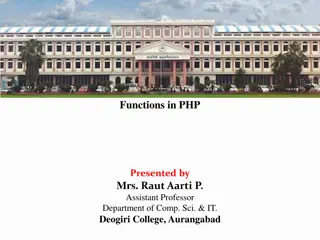
Assessment Models for Open Source Software
Explore various assessment models for evaluating open source software, including the Capgemini Open Source Maturity Model and the Observatory for Innovation and Technological Year Source. These models help organizations assess the quality, maturity, and trustworthiness of open source products to make informed decisions on their adoption.
Download Presentation

Please find below an Image/Link to download the presentation.
The content on the website is provided AS IS for your information and personal use only. It may not be sold, licensed, or shared on other websites without obtaining consent from the author. If you encounter any issues during the download, it is possible that the publisher has removed the file from their server.
You are allowed to download the files provided on this website for personal or commercial use, subject to the condition that they are used lawfully. All files are the property of their respective owners.
The content on the website is provided AS IS for your information and personal use only. It may not be sold, licensed, or shared on other websites without obtaining consent from the author.
E N D
Presentation Transcript
Assessment Assessment Models Models for Software Software for Open Open Source Source Qian Zhenzheng
Convenient Flexible Cost Saving
Outline Outline Assessment Models(OSMM Model, OpenBRR, SQO-OSS) Learning Assessment Models And Assess Software From user s reviews Contributions Methodology NaiveBayes Classifity Latent Dirichlet Allocation Automatic Labeling Topics Rank Sentiment analysis
Assessment Models for Open Source Software Assessment Models for Open Source Software Capgemini Open Source Maturity Model Evaluation Framework for Open Source Software A Model for Comparative Assessment of OpenSource Products Navica Open Source Maturity Model Woods and Guliani s OSMM Open Business Readiness Rating (OpenBRR) Atos Origin Method for Qualification andSelection of Open Source Software (QSOS) Evaluation Criteria for Free/Open SourceSoftware Products A Quality Model for OSS Selection Selection Process of Open Source Software
Assessment Models for Open Source Software Assessment Models for Open Source Software Observatory for Innovation and TechnologicalY ear Source Notransfer on Open Source software (OITOS) Framework for OS Critical Systems Evaluation (FOCSE) Balanced Scorecards for OSS Software Quality Observatory for Open SourceSoftware (SQO-OSS) Evaluating OSS through Prototyping A Comprehensive Approach for Assessing OpenSource Projects An operational approach for selecting open sourcecomponents in a software development project Open Business Quality Rating (OpenBQR) QualiPSo trustworthiness model OpenSource Maturity Model (OMM)
The OSMM The OSMM model model Open Source Maturity Model Open Source Maturity Model The OSMM is designed to enable organizations to evaluate open source products and understand whether a product can fulfill the organization's requirements. Product software, Support, Documentation, Training, Product integrations Professional services
three phases three phases Assess vital product elements for maturity and assign a maturity score. Define a weighting for each element based on the organization's requirements. Calculate the product s overall maturity score(score*weight).
Conclusion Conclusion Disadvantage covering a wide range
The Open Business Readiness Rating The Open Business Readiness Rating (OpenBRR) (OpenBRR) quick assessment detailed
T The he process of assessment process of assessment 1.a quick assessment to rule in or rule out software packages and create a shortlist of viable candidates 2.ranking the importance of categories or metrics 3.processing the data 4.translating the data into the Business Readiness Rating. A software component s Business Readiness Rating is scored from 1-5, with one being Unacceptable, and 5 being Excellent.
Conclusion Conclusion Disadvantage Some Attributes is not available
The SQO The SQO- -OSS quality model OSS quality model an automated software evaluation system evaluates all aspects of OSS development, both the product (code) and the community
The SQO The SQO- -OSS quality model OSS quality model
Step Step Phase One: Definition of the evaluation model 1. Definition of the model criteria (attributes and sub-attributes). 2. Definition of metrics. Phase Two: Definition of the aggregationmethod 1. Definition of the evaluation categories 2. Definition of the profiles of those categories
Evaluation Process Evaluation Process
conclusion conclusion Advantage automated software evaluation system Disadvantage the evaluation procedure is too rigid and a bit cumbersome
Learning Assessment Models And Assess Software From user s reviews
divided into three different areas: internal quality target usage quality external quality
Contributions 1. Measuring software quality with minimum human interference 2. Taking into account all the aspects that are relevant to the user 3. Flexible strong scalability 4. Fine grained quality assessment
NaiveBayes Classifity type rule class example Functional flaw that produces incorrect or unexpected None of the pictures will load in my news feed. It lags and doesn't respond to my touch which almost always causes me to run into stuff. Performance flaw that degrades the performance of Software informative Amazing app, although I wish there were more themes to choose from. Requests to add/modify features Requests to remove advertisements/notifications So many ads its unplayable! This game is adding for too much unexplained permissions. Great fun can't put it down! http://alias- i.com/lingpipe/demos/tutorial/eclipse/r ead-me.html Requests to remove permissions Pure user emotional expression Noninformative Advertisement
N Gram If T is a sentence constructed by words(W1 W2 W3 .Wn) P(T)=P(W1W2W3 ..Wn) =P(W1)P(W2|W1)P(W3|W1W2) P(Wn|W1W2 Wn-1) P(T) =P(W1W2W3 Wn) =P(W1)P(W2|W1)P(W3|W1W2) P(Wn|W1W2 Wn-1) P(W1)P(W2|W1)P(W3|W2) P(Wn|Wn-1)
Topic model P(w|d) = sigma{ p(w|z)*p(z|d) } Doc | ---------------------------------------- | | ... topic_1 topic_2 | topic_m topic_i | ---------------------------------------- | | ... word_1 word_2 | word_n
Rank T1 Pr Pr Pr Pr Pr Pr Pr Pr Pr Pr Pr T2 Pr Pr Pr Pr Pr Pr Pr Pr Pr Pr Pr T3 Pr Pr Pr Pr Pr Pr Pr Pr Pr Pr Pr T4 Pr Pr Pr Pr Pr Pr Pr Pr Pr Pr Pr Tn Pr Pr Pr Pr Pr Pr Pr Pr Pr Pr Pr . . . . . . . . r1 r2 r3 r4 r5 r6 . . . . . . . . . . . . . . . . . . . . . . . . . . . . . . . . . . . . . . . . . . . . rn . . . . . . . .
Rank T1 1.0 1.0 0.5 0.4 0.5 0.1 . . . . 1.0 T2 0 0 0.1 0.2 0.3 0.3 . . . . 0 T3 0 0 0 0.1 0.2 0 . . . . 0 r1 r2 r3 r4 r5 r6 . . . . . . . . rn

